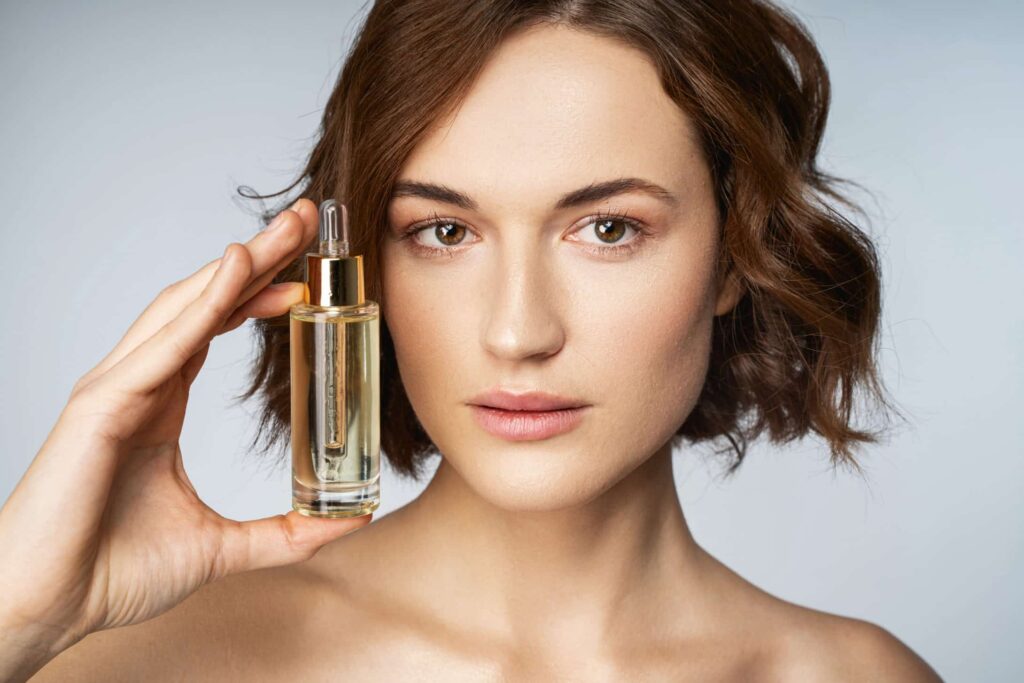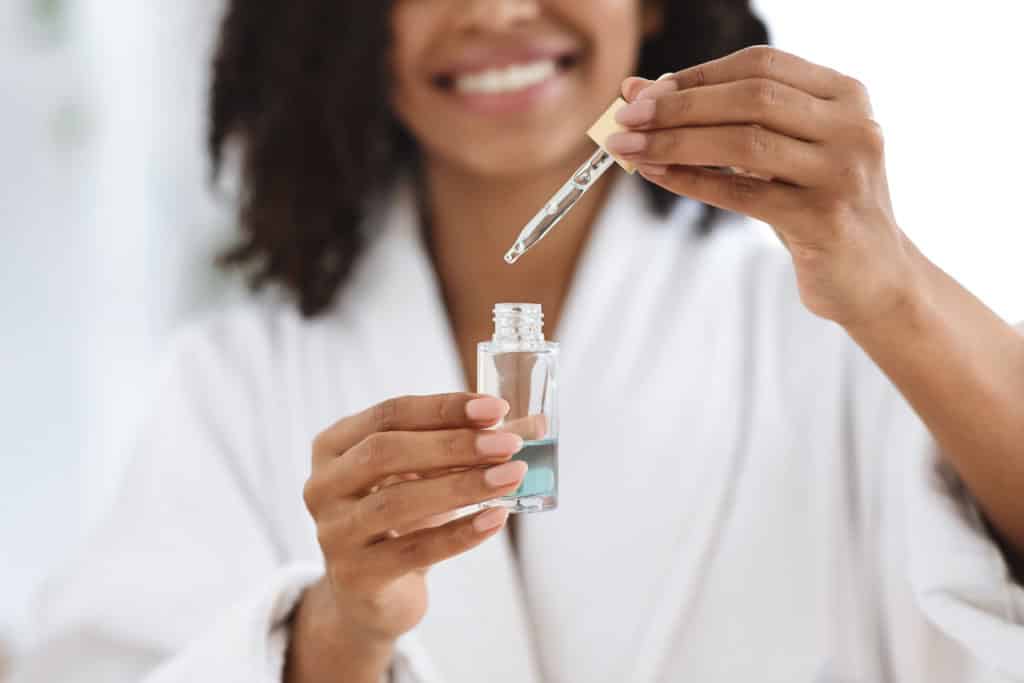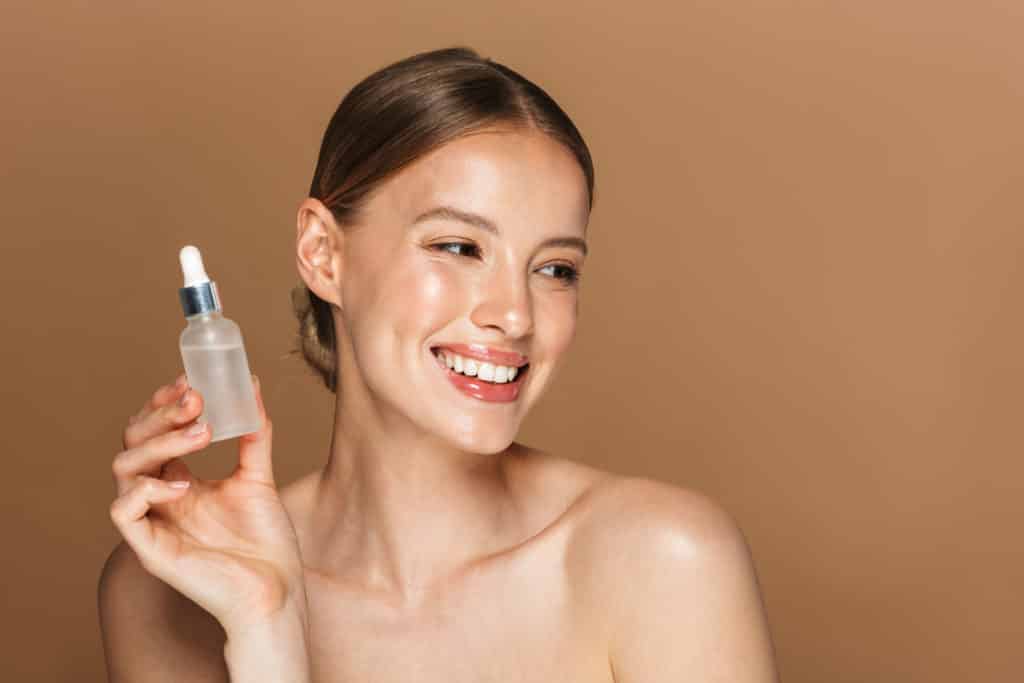The Best Ways To Use Hyaluronic Acid Serum With Vitamin C To Improve Your Skin
We come face to face with our face all throughout the day, whether it’s examining the lines that crumpled sheets left on our cheeks, or staring at ourselves on the computer screen during a virtual meeting. We try to blame what we don’t like on the camera, or a particular angle (we don’t really have that many chins, do we?).
However, there comes a time when we have to face the facts. This is indeed the skin we’re in and we need to make the best of it, as any board-certified dermatologist might say.
The fact is you are beautiful, but there are things you can do to get even more gorgeous. Using a Hyaluronic Acid Serum is one of those things.

Most everyone has heard of Vitamin C, but perhaps not hyaluronic acid – and hyaluronic acid serums at that. Hyaluronic acid is a glycosaminoglycan or, to use a word we can more easily digest, a sugar. And yes, as always, pun intended.
Hyaluronic acid is produced naturally in the human body and is a humectant, which means it binds to water molecules to help retain moisture in the skin. Like collagen, you can find hyaluronic acid doing its thing in the connective tissue of our bodies.
Over time, all skin types start to produce less collagen and elastin, and because the metabolic power of our cells in our skin barrier declines as well, this affects the synthesis of hyaluronic acid. All of these things lead to the appearance of fine lines and wrinkles, dehydrated skin, parched skin, skin that sags, or at least isn’t as firm as before.
Since we lose some elasticity as we age, we may want to look for various options to help slow down this process. Here are seven ways to use the hydrating power of hyaluronic acid serums to improve your skin tone and get back that dewy skin texture you’ve been chasing after:
See Related: Best Hyaluronic Cellular Recovery™ AHA Serum
1. Order up with hyaluronic acid! After a toner, before a moisturizer
Order is of utmost importance when it comes to skincare. Generally we follow the cleanse, tone, and moisturize series of steps.
When we add in a hyaluronic acid serum, it should come after a toner and before the moisturizer in order to optimize the absorption of weights of hyaluronic acid. Repeat after me: after a toner, before a moisturizer. A toner prepares the damp skin pores for the following step, and we want serums to penetrate deep into the skin.
If you are applying a Vitamin C serum and hyaluronic acid separately, it’s suggested that you apply the Vitamin C first, and then add the hyaluronic acid afterward in order to help fortify the skin barrier and lock in the moisture. Many Vitamin C serums already include that healthy dose of weights of hyaluronic acid, so you don’t have to add it in as a separate step.
After applying a hydrolyzed hyaluronic acid serum (or serums), wait a few moments for it to absorb, and then gently smooth on your regular moisturizer.
2. AM or PM? For hyaluronic acid, maybe even both
As with any new ingredient you apply to your skin, you should be sure you don’t have any allergic or otherwise negative reactions. Especially if you’re one of those sensitive skin types, or simply have dehydrated skin or dry skin.
So if you are just starting to incorporate a serum or hyaluronic acid product in your skincare routine, we suggest you select either morning or evening and insert it in those cleansing, toning, and moisturizing steps.

Once you are sure your skin is good with the hydrating serum or hydrating serum packs you’re using, you can up your usage to twice a day, working it into both your morning and evening routines. You’re sure to see even more remarkable results.
But don’t get greedy or be too tempted to add another application in there. Once or twice a day should do the trick. Any more than that and you may risk having some irritated skin.
See Related: Advanced Anti-Aging Night Cream ™ & Moisturizer & Gluten Free Skincare
3. Less is More when it comes to hyaluronic acid
Some of us get so excited about a new skincare product that we spread it on like an extra helping of butter on a baked potato. But wait, do we really need that much? I’ll let you be the one to decide about that additional bit of butter, but as far as serums go, a little goes a long way.
They come in concentrated formulas with molecular weights of sodium hyaluronate that pack a punch. Usually you’ll use a pea-sized amount no matter your skin type, or perhaps a bit more.
But simply follow the instructions. The goal is to use enough hyaluronic acid to cover the area without having to waste any excess of that delicious oil-free formula.
The good news is you’ll help lengthen the silk proteins, amino acids, and general shelf life of your serum, which is a bonus because they sometimes don’t come cheap. However, once you see the results of using hyaluronic acid regularly on your parched skin, you’ll probably appreciate the investment.
Here’s a whole host of helpful HOW TOs when it comes to serums, if you want to travel further down the rabbit hole of the best hyaluronic acid serums out there.

4. Banish acne and breakouts with hyaluronic acid
Who knew the same face could be blessed with both acne and the appearance of fine lines? If you thought the days of acne breakouts on oily skin would be long gone by now, but are still dealing with the same T-zone troubles that plagued you your freshman year of high school, there’s some good news for you.
If acne is something you deal with on a daily, weekly, or monthly basis, then a hydrating hyaluronic acid serum may just have some hidden benefits to fight those blemishes and generally oily skin.
Since Vitamin C is an antioxidant, it helps fight free radicals that wreak havoc on cells, which means it works against pesky triggers for inflammation. So, the redness and inflammation related to acne prone skin or dehydrated skin should subside when coming into contact with Vitamin C.
Then how does hyaluronic acid figure in, you ask? Excellent question. Hydrolyzed hyaluronic acid, as discussed above, is all about hydration. When you (unintentionally) clog pores, acne breakouts are often a result of the buildup of dead skin cells, making for that grody skin texture.
And without proper hydration it’s hard to have a smooth process of skin cell regeneration. Hyaluronic acid can boost the moisture barrier of your skin, thus shutting out some bacteria. So banish those breakouts and send them back to the past for good.
5. Throw a wrench – and some hyaluronic acid – into wrinkles
Now that we’ve gone over some of the benefits that hyaluronic acid has on acne prone skin, let’s remember why they work wonders on sensitive skin and the appearance of fine lines and wrinkles. Hyaluronic acid can help repair damage done by oxidative stress brought on by sun exposure and other harmful elements in the environment.
Also, since the presence of hyaluronic acid spurs on the production of collagen, it lessens the look of those fine lines and wrinkles that all skin types would like to forget.

Hyaluronic acid basically fills in the lines of dry skin or sensitive skin by going deep into the dermis and doing its thing, which is to help plump skin by drawing in moisture. It’s key to keeping skin soft and supple through a mineral complex, oil-free formula.
It’s just as important to reintroduce it to your skin through well-formulated products as it is to ingest it and boost hydration levels by eating foods rich in amino acids and bio-fermented zinc like pineapple ceramides.
So tell those beans, bone broth, and other amino acids to get it in your belly already! Seriously, those molecular weights of sodium hyaluronate will actually help your skin type strengthen and soften.
6. Get over those under-eye circles with hyaluronic acid and deal with discoloration
It’s not just genetics and skin types that determine whether or not you happen to have dark under eye circles. Though that definitely plays a part, there are a few things that are actually under your control.
First off, you should make sure you’re getting enough sleep, drinking plenty of water and eating well. As usual, it’s always easier said than done, but do the best you can. Secondly, consider the contents of serums and creams you use.
A serum that boasts hyaluronic acid brightens the skin by speeding up skin cell turnover. It’s like shining a light on the shadow under your eyes. There is some evidence to suggest that it may improve the look of the under-eye area by slightly thickening the dermis and concealing the darker coloration.
In addition, there may be some subtle stimulation of collagen production, as previously mentioned, which aids in a more youthful and refreshed look.
It’s for these same reasons that the best hyaluronic acid cream or serum can help combat inconsistencies with coloration and be your best bud when it comes to brightening.
7. Incorporate a hyaluronic acid serum in a whole-self beauty challenge
Get ready for your close-up and take an inventory before you embark on a unique beauty challenge. Since we know our skin is affected by what we put in and on our bodies, try some new habits for six weeks and see what a difference it can make for you. Be sure to take some before and after pics to see if you notice an improvement.

Set your own specific goals for this challenge. And while you’re at it, here’s a tutorial on self cranial massage you can do at home:
If you don’t already use any kind of serum, I’d suggest one like Viviane Woodard’s Best Hyaluronic Acid Moisturizer: Vitamin C Restoring Serum (see product). This is one of the best hyaluronic acid products which boasts collagen boosting ingredients and a whole host of skin-healing herbs and hydration benefits.
In addition to Vitamin C and hyaluronic acid, it contains extracts of Rose Hips, Green Tea, Arnica, and the always awesome Aloe Vera. Specially formulated to plump and hydrate, this serum will leave your skin supple and soft to the touch as it smoothes fine lines and wrinkles. It improves circulation and gives your skin new life, so you look in the mirror and love what you see.
Keep Reading: Enriched Water Based Moisturizer™
—
For over 60 years, Viviane Woodard has represented “The Purity of Skincare”. We are the leading beauty brand for water-based skin care products and promote the importance of good skin hydration. Follow us on Facebook, Instagram, Twitter, and Pinterest for skin care tips, product discounts and more.
